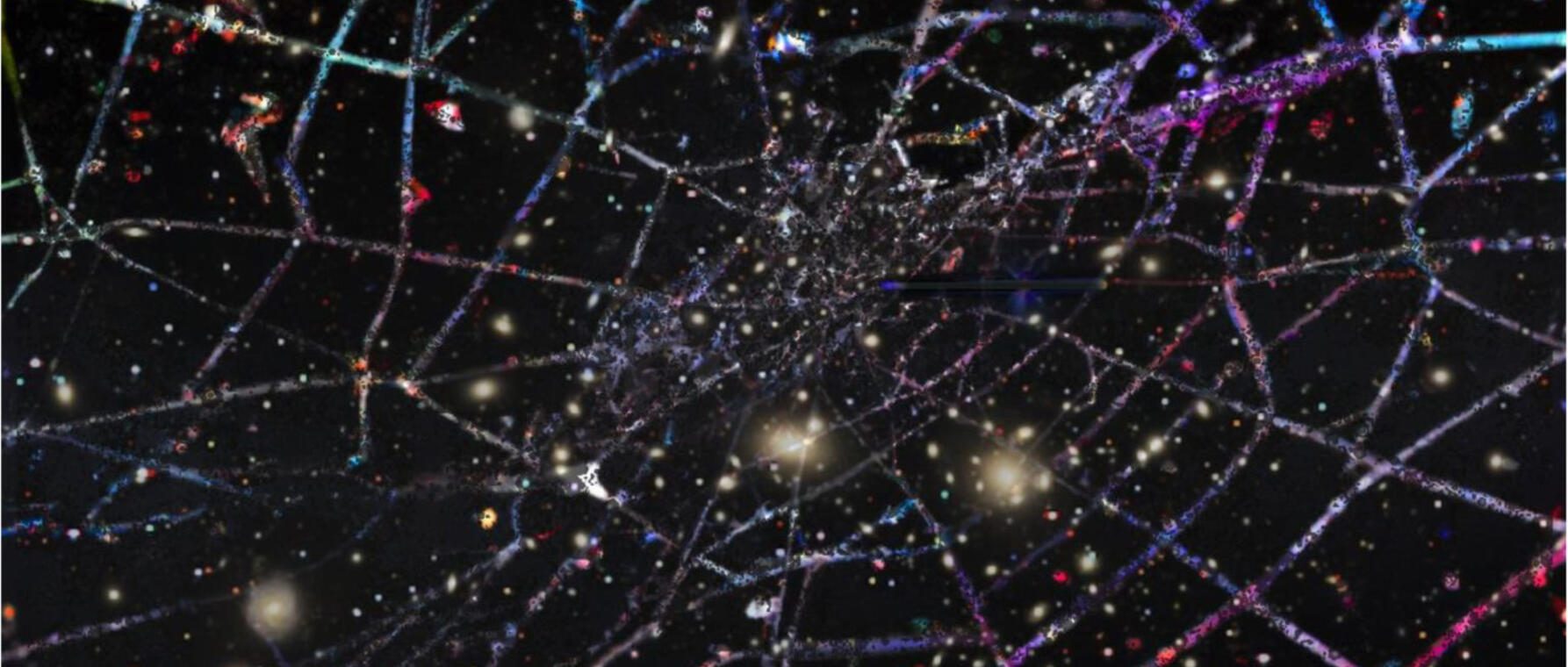Untangling the Cosmic Web
Gauging the intrinsic alignment of galaxies for a more accurate map of the universe

Research at Risk: Since World War II, universities have worked with the federal government to create an innovation ecosystem that has yielded life-changing progress. Now much of that work may be halted as funding is withdrawn. Find out more about the threats to medical, engineering, and scientific research, as well as how Harvard is fighting to preserve this work—and the University's core values.
Imagine the structure of our universe as a cosmic-sized spider web. Galaxies cluster along the web’s strands and nodes. Since the Big Bang, a mysterious force called dark energy has been stretching the overall geometry of the web very quickly. At the same time, however, gravitational forces operating on the galaxies are pulling matter closer together, albeit at a slower rate than we would expect due to the counter-effect of dark energy. The result is a bit of a paradox, according to 2024 Harvard Horizons Scholar and astronomy PhD student Claire Lamman.
“The web of the universe is becoming more and more defined,” she says. “The nodes are becoming denser, even as the size of the web is growing.”
Lamman is part of a team of astrophysicists using data from the Dark Energy Spectroscopic Instrument (DESI) to map as many as 50 million galaxies. Her Harvard Horizons project, “Untangling the Cosmic Web,” describes Lamman’s distinctive contribution to this effort—gauging the “intrinsic alignment” of galaxies to better understand the universe and how it evolves.
Mapping the Universe
Located at the top of Kitt Peak, about 50 miles southwest of Tucson, Arizona, DESI—and its 5,000 tiny robots—has already measured the distances to 40 million galaxies. The map that the instrument is creating allows scientists to see how the structure of the universe evolved over time.
“Light takes time to travel,” Lamman explains. “The galaxies that DESI sees contain light of varying ages. Looking at galaxies that are more distant is looking further back in time.”
To understand how old this light is, astronomers use spectroscopy, a technique that identifies the constituent parts of the light emitted from galaxies at varying distances. The color of a galaxy’s light—specifically its redness—reveals how fast it’s moving away from the Earth. This is directly related to its distance and, therefore, age.
“Think of the shift in the redness of a galaxy’s light like the change in the pitch of a train’s horn as it zooms past you,” Lamman says. “Sound waves sent out by something moving away are spread out and sound lower. Light from a galaxy moving away from us will be stretched and appear redder. Then, the faster a galaxy is moving away from us, the more distant it is. This is because space is expanding. The further away a galaxy is from us, the more space there is between us and it to expand.”
Although DESI is capturing the data of a record 50 million galaxies, most of the web is made of invisible dark matter. To build a reliable map of the universe based on the data from those 50 million galaxies, astronomers need to understand how the galaxies are connected to the underlying web.
Galaxies are not scattered randomly throughout the universe but tend to correlate like strands where there appears to be more dark matter. (Hence, the analogy of a web.) The gravitational pull of dark matter also affects the shape and orientation of the galaxies.
[Because DESI’s sample bias privileges galaxies pointed toward Earth,] some troughs look “troughier” and some peaks look “peakier” than they should in reality.
—Clare Lamman
Bright Privilege
DESI’s criteria for which galaxies it chooses to capture depends on how bright the target galaxy is. But Lamman says the brightness of a galaxy is influenced by its orientation relative to the Earth.
“Big galaxies tend to take the shape of ovals, and they tend to point toward the denser parts of the cosmic web of the universe,” she says. “Thus, galaxies in the troughs, where there is less dark matter, tend to point toward the strands of the web. And galaxies in the strands tend to be aligned with the strands.” Because DESI’s sample bias privileges galaxies pointed toward Earth, “some troughs look ‘troughier’ and some peaks look ‘peakier’ than they should in reality.”
This sample bias makes data less representative of the universe as a whole. Given the cosmic scale of the research, even the tiniest errors can compound and skew astronomers’ understanding of the universe.
That’s where Lamman’s research comes in. She studies the true shapes and orientations of the galaxies—their intrinsic alignments. Spectroscopy provides Lamman data on millions of galaxies, which allows her to make statistical inferences about their orientation in ways that were not possible before DESI. Based on that information, Lamman writes in her Harvard Horizons proposal that “we observe more clustering along the line-of-sight than in the plane of the sky.” She predicts that these alignments will bias DESI’s measurements by nearly 1 percent, a problem for a precision-cosmology survey that is designed to make measurements with sub-percent precision.
“One percent is a tiny fraction of our overall measurement, but a large portion of our error budget,” she says. “We need my corrections to distinguish between certain models of dark energy.”
Daniel Eisenstein, the Paul C. Mangelsdorf Professor of Astronomy at Harvard University and Lamman’s faculty advisor, says the Harvard Horizons scholar’s work brings astronomers closer to a more accurate inventory of the universe and everything in it.
“Claire studies how the orientations of galaxies point toward distant galaxies,” Eisenstein says. “This is only a slight trend, but it carries the opportunity to measure the gravitational effects of the unseen ‘dark’ matter of the Universe in a new way. With the emerging generation of large surveys of galaxies, we now can harness this tool.”
One percent is a tiny fraction of our overall measurement, but a large portion of our error budget. We need my corrections to distinguish between certain models of dark energy.
—Clare Lamman
Universal Questions
Lamman says she wants the impact of her work to extend beyond the observatory and academia. A passionate advocate for public outreach around science education, she has produced a planetarium video that explains how DESI works—as well as doodle annotations of her scientific papers intended for nonexperts. Last May, dozens of students and researchers from the Harvard Center for Astrophysics attended the video’s premiere at Boston’s Museum of Science. “The narrative about the project and its participants was compelling and the visuals were stunning—it was brilliantly done!" says Doug Finkbeiner, professor of astronomy and physics at Harvard and one of Lamman’s dissertation committee members.
In the years ahead, Lamman hopes to inspire others to pursue the big questions that are the inspiration for her research. While she knows that the layperson may not immediately understand the significance of her work, she says the impulse that lies behind it is, no pun intended, universal.
“I’m searching for answers to very fundamental questions,” she says. “What is the universe made of? And how does it change? The answers leave imprints in the galaxies we observe, which are uniquely traced by intrinsic alignments.”
Learn more about the 2024 Harvard Horizons Scholars and see them on stage at the campus-wide Harvard Horizons Symposium in Sanders Theatre on April 9.
Get the Latest Updates
Join Our Newsletter
Subscribe to Colloquy Podcast
Simplecast




